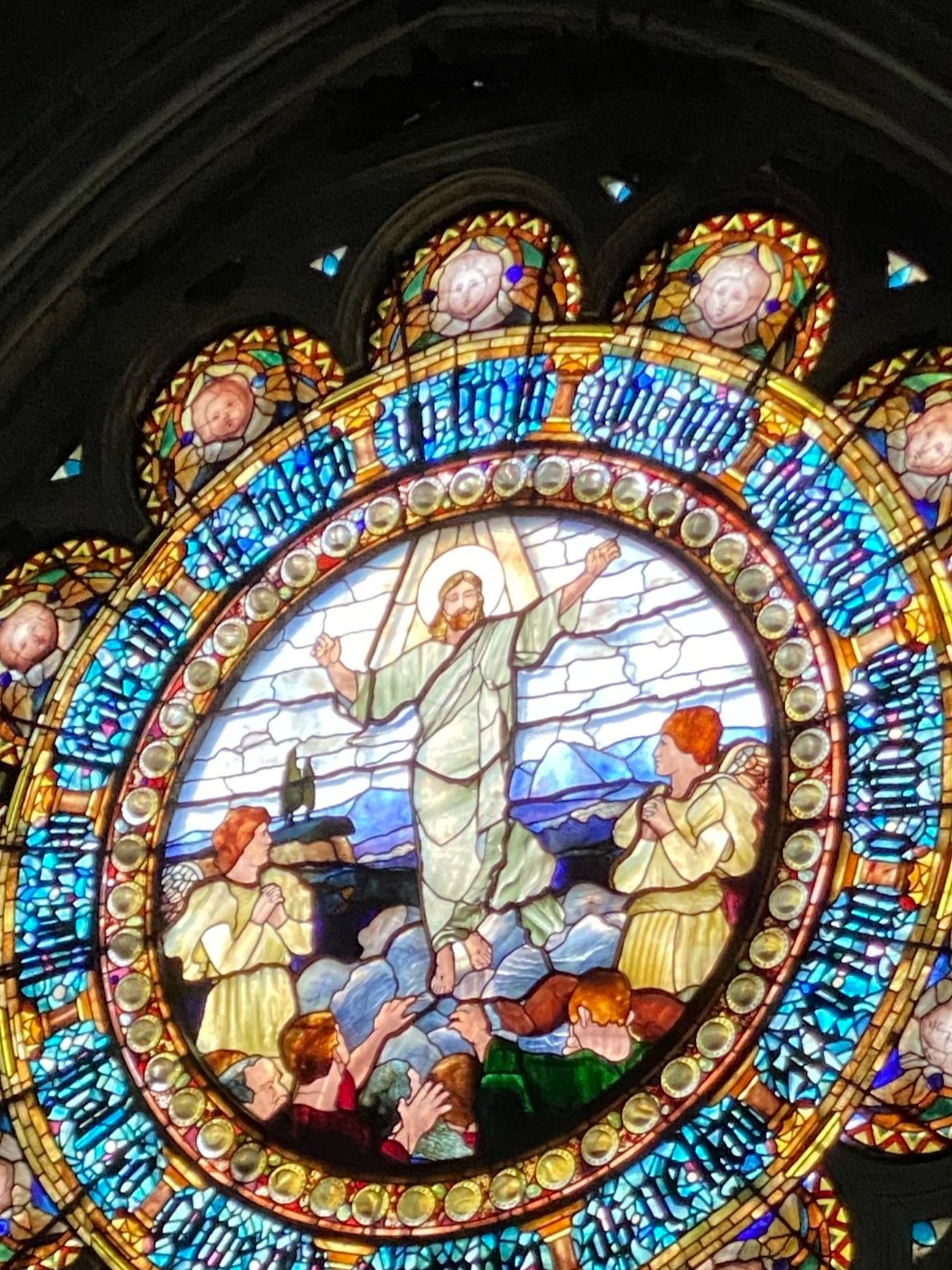
St. Stephen’s Tiffany Windows
St. Stephen’s has a collection of over 41 Tiffany stained glass and decorative leaded glass windows, which are among, and possibly, the oldest ecclesiastical Tiffany windows in the world. All of the windows were commissioned in 1879-1880 with final installation occurring by autumn, 1881. Since the entire construction of this parish church was given by one donor, the Honorable Enoch Redington Mudge, in memory of his deceased children, Fanny Olive (Mudge) Van Brunt and Lt. Col. Charles Redington Mudge, all of the windows are of the same age and period. Of these, the most interesting are two large lancet windows, were designed by Francis Davis Millet and two large rose windows were designed by Augustus Saint Gaudens both for Louis Comfort Tiffany. 19 of these windows are double-glazed, which means there is both an interior and exterior window. This was an early attempt in Tiffany’s designs to create depth by using the outside window to highlight some colors while modifying other colors. None of the Tiffany windows at St. Stephen’s Church contain any paint, eliminating what Tiffany’s later critics called a “cooked fish” appearance. Flesh features were created by plating the glass, until the desired skin-tone was reached. Meanwhile facial features were created by etching the glass, a process that used hydrochloric acid and by molding the lead lines. ”
-

St. Stephen Preaching As A Child
Designed by Francis Davis Millet (1846-1912) for Louis C. Tiffany & Co., Associated Artists, New York. This is one of a pair of lancet windows facing west, at the end of the nave, depicting St. Stephen, a deacon in the early church, and first martyr of the Christian faith, preaching outside a community with clearly an Eastern appearance. Tiffany uses many types of glass, including confetti glass (notice the over-cloak on the man standing to Stephen’s right), ripple glass and glass which appears to have gold flecks in it. Stephen’s face is several panes of glass thick, with the bottom piece having very detailed facial features etched into it. This window is best viewed in the late afternoon and illuminates the church as if it were entirely candlelit. Further, through the restoration process in 2004, it was discovered that all the lead lines in the cartoon were painted gold, creating an illusion at night that there is light coming in from the outside. Also, much of the building’s architecture is mirrored in the window surrounding the cartoon.
-

St. Stephen Being Stoned To Death
Designed by Francis Davis Millet (1846-1912) for Louis C. Tiffany & Co., Associated Artists, New York. This is one of a pair of lancet windows facing west, at the end of the nave, depicting St. Stephen, a deacon in the early church, and first martyr of the Christian faith, being executed outside a community with clearly an Eastern appearance. Here too, Tiffany uses a lot of ripple glass to give depth to the peoples’ clothing. Stephen’s hands and the face of the man to the viewer’s right of Stephen, are made of etched glass, also several panes of glass thick. The stones being thrown at Stephen are glass jewels, which radiate the late afternoon sunlight refracting it in many directions. This window is best viewed in the late afternoon and illuminates the church as if it were entirely candlelit. Further, through the restoration process in 2004, it was noted that all the lead lines in the cartoon were painted gold, creating an illusion at night that there is light coming in from the outside. Also, much of the building’s architecture is mirrored in the window surrounding the cartoon.
-

The Annunciation
Designed by Augustus Saint Gaudens (1848-1907) for Louis C. Tiffany & Co., Associated Artists, New York. This is one of only two stained glass windows ever designed by Saint Gaudens. This rose window, measures 13 feet in diameter, depicts the Virgin Mary with the angel Gabriel. In the 12 petals of the rose, are cherubs, whose facial features are created by molded lead. The garments worn by Mary and by Gabriel are given depth by using rippled glass. The facial features and hands are all given detail by etching and plating the glass. Being the south transept window, it is best viewed from late morning into early afternoon, especially in the late spring and summer months. The cost of this window was $4,000 in 1880.
-

The Ascension
Designed by Augustus Saint Gaudens (1848-1907) for Louis C. Tiffany & Co., Associated Artists, New York. This is the second of only two stained glass windows ever designed by Saint Gaudens. This rose window, measures 13 feet in diameter, depicts Jesus Christ ascending into heaven, observed by Christians on the 40th day after Easter. This window is often mislabeled the Transfiguration. In the 12 petals of the rose, are cherubs, whose facial features are created by molded lead. The garments worn by Jesus, the angels and the disciples are given depth by using rippled glass. The facial features and hands are all given detail by etching and plating the glass. Being the north transept window, it never receives any direct sunlight, however around the summer solstice, a portion of the window does get some sunlight at sunset. The cost of this window was $4,000 in 1880.

